BOOKS
Learning from books can be a limited way of teaching yourself how to play rhythm and percussion in my opinion. Firstly if you have no experience in written musical notation then there is a whole theory with symbols to learn before you can start. Unfortunately there is no standard notation and so you need to learn new ones or adapt what you have learned as you come into contact with new sources of information. Visually you are limited to static images - photos or diagrams, which attempt to explain and demonstrate how to hit the drum. Obviously a live person or a DVD / Video give you the chance to observe technique in real time and/or three dimensionally. However everyone responds differently to different forms of tuition and you may find the following books useful or certainly as accompanying information. All the following have CD's / Tapes which accompany the books so you can hear how the rhythms sound.
BOOKS.
Scroll through the BOOK's and move cursor over the area to pause.
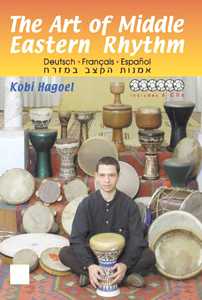
LINKS
THE ART OF MIDDLE EASTERN RHYTHM.
by Kobi Hagoel.
Hardbound, A4 size, 136 pages with 6 accompanying CD's - published by OR-TAV Music Publications.
Kobi Hagoel's The Art of Middle Eastern Rhythm is one of the most complete book ever written on the subject
The book features well over 400 different rhythms collected from a vast geographical area including North Africa, the Eastern Mediterranean, Greece, Turkey, the Balkans, Saudi Arabia, Iraq, Iran, and Central Asia.
Each rhythm is notated, and explanations are provided of the rhythm's origin and use, as well as alternate names for the rhythm from other locales.
In addition to the exceptional collection of rhythms, the book includes an introduction to the history and theory of rhythm in the Middle East, an illustrated section describing Middle Eastern percussion instruments, and a series of pictures demonstrating the correct way to hold a darbuka, riq, zarb, and daf for each of the different drum strokes
Exercises are provided for beginners, which experienced players will find beneficial as well
The text appears in English, German, French, Spanish, and Hebrew
To top it off, the book includes 6 CDs, on which all of the exercises and rhythms are recorded 136 pages + 6 CDs
Product review from author's site.

LINKS
DOUMBEC DELIGHT.
By Mary Ellen Donald.
A 30 Lesson Course in Middle Eastern Drumming, with Basic Music Theory.
(1976)
Includes:
• Basic music theory
• Simple and fancy drum techniques
• Middle Eastern rhythms
• Guidelines for creating rhythmical variations
• Tips for accompanying belly dancers, and
• Practice suggestions
Companion Discs for Doumbec Delight
These CD's include Mary Ellen playing most of the examples in the book several times, improvising solos, and playing the accent patterns of each rhythm at length to provide a steady backup for student practice.
Volume I Covers Lessons 1-10
Volume II Covers Lessons 11-30
Product review from author's site.
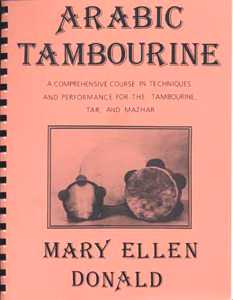
LINKS
ARABIC TAMBOURINE (INCLUDES TAR).
By Mary Ellen Donald.
A Comprehensive Course in Techniques and Performance for the Tambourine, Tar, and Mazhar (1985)
Includes:
• Basic music theory
• Techniques for playing cabaret and classical tambourine, tar (wooden frame drum), and mazhar (giant tambourine)
• Several variations for each of the following Arabic rhythms:
Ayyoub
Baladi
Maqsum
Malfouf
Saudi
"Walking" Maqsoum
Masmoudi
"Mellow" Masmoudi
Bolero (Rhumba)
Chifte-telli
Karachi
Bayu
6/8 Rhythm
Syncopated Masmoudi
Zaffah
Fallahi
Wahidah
Fast Chifte-telli
Sama'i Thaqil
Sama'i Darij
Murabba
Dawr Hindy
Mahajjar
Masmoudi Variation
Nawwari
Sa'idi
Libi
Tayir
Companion Discs for Arabic Tambourine
Mary Ellen plays all of the examples in the book several times and includes improvised solos.
Volume 1 Covers the cabaret tambourine.
2 CD
Volume 2 Covers the classical tambourine, tar, & mazhar.
2 CD set
Product description from author's site
Review from author's site:
Arabic Tambourine
A Comprehensive Course in Techniques and Performance for the Tambourine, Tar and Mazhar
by Mary Ellen Donald
Why does the professional performer or dance instructor need to study Mary Ellen Donald’s Arabic Tambourine text? For these reasons and more: her book presents the rhythms heard in Egyptian video tape performances. Professional performers (musicians, dance troupes and dancers) and dance instructors need the knowledge base of rhythms and the cultural background of the music to enhance their professional skills and abilities. Can you recall watching a show where the performer (musician or dancer) missed the “breaks” in the music, or danced right through them? Or a dancer who has danced only to the iqat (rhythmic mode) and who perhaps may not have known the maqamat (melodic mode) may differ from the iqat?
Product review from author's site.
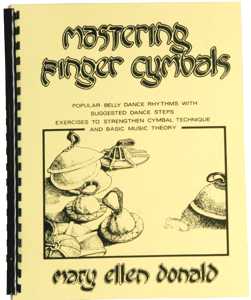
LINKS
INSTRUCTIONAL BOOK AND CD'S FOR FINGER CYMBALS.
By Mary Ellen Donald.
Beginner Cymbal Discs for Belly Dancers
by Mary Ellen Donald (1977; remastered 1999; disc released 2005)
After giving a brief lecture on rhythm and cymbal technique, Mary Ellen presents instructions for combining simple cymbal patterns with simple dance steps while providing a drum accompaniment throughout. An introduction to popular belly dance rhythms is included. This CD is useful for individual and group practice sessions.
Companion Discs for Mastering Finger Cymbals
(1976; remastered 1999; disc released 2005)
Mary Ellen plays most of the examples in the book several times. She also includes drumming sections so that students may practice improvising to the accompaniment.
2 CD Set
Product review from author's site.

LINKS
METHOD FOR DARBUKA VOLUME 1.
By Ruben van Rompaey.
Darbuka book, including clear instructions and photographs, self-study
Level: starter
44 pages
language: English
Product review from author's site.
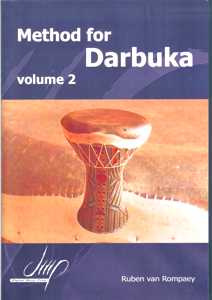
LINKS
METHOD FOR DARBUKA VOLUME 2.
By Ruben van Rompaey.
Darbuka book, including clear instructions and photographs, self-study
Level: 2nd level
44 pages
language: English
Product review from author's site.

LINKS
PLAY THE DARBUKA.
By Ruben van Rompaey.
Darbuka, playing material for the method Play the Darbuka
book, ensemble pieces in various configurations
Level: starter/intermediate
44 pages
language: English
Product review from author's site.
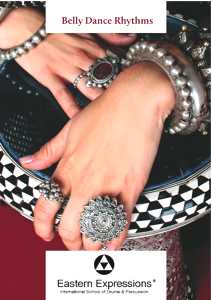
LINKS
BELLY DANCE RHYTHMS.
By Ruben van Rompaey.
This little book that fits in your pocket contains 51 Belly Dance Rhythms, a must have for every Darbuka player!
Each rhythm has two versions: a basic rhythm and a full rhythm.
Rhythms: 51
Format: A6 (H 148 mm (5.83 in) x W 105 mm (4.13 in)
Pages: 10
Product review from author's site.

LINKS
THE MAGNIFICENT DARBUKA RHYTHMS - A BEGINNER'S GUIDE.
By Ramzi Besharat and the Galilee Percussion Ensemble.
It gives us great pleasure to present the venerable tradition of playing the darbuka drum using a method that makes it easy to hear and simple to learn. The rhythms which will introduce you to this enchanted world have been chosen with care and are played by Ramzi Besharat and the Galilee Percussion Ensemble. Slow rhythms (played at a slow pace) are customary in artistic music; Rhythms used in both artistic and popular music; Fast-paced rhythms (played at a lively pace) and Rhythms used in popular or folk music.
1) Part One: The Percussion Instruments (2) Part Two: The Sounds (3) Part Three: Exercises (4) Part Four: The Rhythms (5) Part Five: Minus One (6) Part Six: Rhythm Sequences Rhythm Notation.
Product review from author's site.
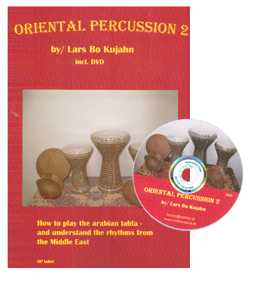
LINKS
ORIENTAL PERCUSSION 2.
By by Lars Bo Kujahn.

LINKS
DARBUKA METHOD, ADVANCED DARBUKA TECHNIQUE.
by Behnan GÖÇmez.
Softbound, A4 size, 55 pages with accompanying CD - published by Mel Bay Publications.
The darbuka is a goblet-shaped small hand drum that is widely played in classical and folk music, especially in North Africa and Turkey. It is commonly available in Egyptian and Turkish varieties. The instrument is also known by various other names including darabukka, darbuquah, or tombak. This method presents intermediate to advanced instruction including playing positions, techniques, and rhythm exercises. Numerous photographs and diagrams aid comprehension of the material, as does the companion CD, which demonstrates all of the exercises and examples in the book. Advanced techniques covered in this text include: the up position, the finger tick, clap stroke, 3-2-3 technique, hammer technique, the slap technique, and dampen technique. The text is presented in English, French, and German.
Product review from author's site.
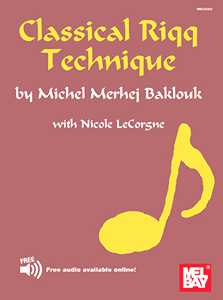
LINKS
CLASSICAL RIQQ TECHNIQUE. (eBook)
by Michel Merhej Baklouk, with Nicole LeCorgne.
Built around the life and teachings of master percussionist, Michel Merhej Baklouk, this book has been designed as a biographical tribute, a teaching manual, and a resource guide for anyone wishing to develop a deeper understanding of the role that percussion plays in Near Eastern Arabic music. This book differs from most technique manuals in that it includes historical information on about Arabic music as it pertains to the life and work of a single artist, Michel Merhej Baklouk. The book is composed of three parts: Introduction, Lessons, and Reference Information. Each part is written to stand on its own as well as fit with the whole so that readers can approach the book either as individual articles and lessons, or in its entirety, to be read from cover to cover. By presenting Michel's work in this way, we hope to appeal to a wider audience percussion students at varying skill levels and from varying music disciplines and backgrounds, students of music and Middle Eastern studies, or anyone else interested in twentieth century Arab music and culture. The first part, Introduction, contains several essays about Michel's life, his teaching philosophy, pedagogical practices, musical aesthetics and performance practices. Although these sections may be read independently, they are also designed to help percussion students apply the book's lessons to their own playing and musical interpretations. The technical focus of this book is on the riqq; however, students of Arabic music (beginning through advanced) can adapt the practical exercises to gain mastery of the percussion instrument(s) of their choice. The second part, Lessons, begins with information about how to hold the percussion instrument (case in point: the riqq) and how to practice effectively. It then presents the body of exercises that Michel developed for his students. These exercises have been taken directly from Michel's notated lessons, which he developed into units corresponding to levels of proficiency, or academic years as he taught them at the Conservatory in Beirut; however, for the purposes of this book, the exercises are reorganized to correspond to subject matter and only roughly mirror Michel's conservatory sequence. Unit 1, Technique Building Exercises, is aimed at novice players or anyone who is new to reading music. Units 2 through 5 focus on specific rhythmic structures with increasing complexity. Students should master each unit of exercises before proceeding to the next unit. The third part, Reference Information, includes a notation reference, a list of rhythms, a list of further reading recommendations, and a glossary of Arabic music terms, many of which are used in the text. All Arabic words in this book appear in italics, except proper names, and with the exception of some proper Arab names, the text is essentially written in the standard system of transliteration used by the Library of Congress and most academic literature Throughout the book you will see quotations from Michel offset in the text. These prosaic tidbits may be words of wisdom, interesting anecdotes about Michel's life, or insights into his work and world of music. Each provides a glimpse into the personality of this exceptional musician. As a technical manual for students of Arabic percussion, Classical Riqq Technique provides specific exercises and explores important concepts,some of which are rarely taught, even in private lessons. At the same time, this book strives for a broader goal to present and preserve classical percussion from the perspective of a master who not only lived in but also influenced the golden age of Arabic music.
Product review from author's site.

LINKS
ARAB PERCUSSION METHOD – VOLUME ONE.
by Hafez Kotain.
This booklet provides a structured method for educators and students to learn Arab music. The basic sounds on a hand drum are explained with music notes, followed by four lessons with exercises and solo arrangements for a percussion ensemble (28 pages).
Product review from author's site.

LINKS
MID-EAST DOUMBEK TUTOR BOOK.
by Steve Kundrat.
For the beginner. Contents includes: styles of Doumbeks, playing position, hand techniques, and 50 popular rhythms.
Product review from author's site.

LINKS
FINGERS OF FURY TRIAL BOOK.
by Matt Stonehouse.
Percussion of the Arabic world and Beyond
Teaser.
Product review from author's site.
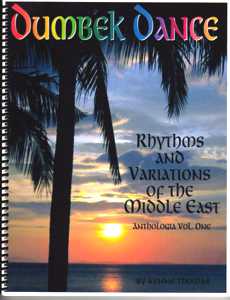
LINKS
DUMBEK DANCE.
by Kenne Thomas.
This newest book by author Kenne Thomas, is volume one from the comprehensive Middle Eastern rhythm study text, "ANTHOLOGIA." Vol Two covers the animated rhythms of Zills and Riqq for dance. This book is a categorized rhythmic study of the intricate and mesmerizing "Iqa'at," the modes and patterns of Middle Eastern dumbek drum performance.
Chapter on dumbek instruments, "Iqa'at" (Rhythmic modes) and handing techniques with photographs.
Authentic Middle Eastern rhythm patterns from Adani to Zeimbekiko
Chapter covering rhythm terminology for reading and interpreting the Middle Eastern patterns.
Rhythms of al Andalus, the Balkans, Persia, the Maghreb, the Levant, and other regions.
Dumbek patterns and techniques for rhythm variations, improvisation and soloing.
Recommended recordings list of dumbek, zills, riqq and belly dance performance music.
Product review from author's site.
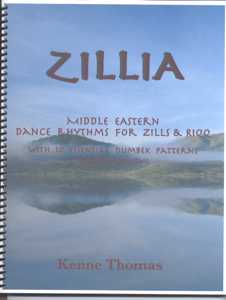
LINKS
ZILLIA.
by Kenne Thomas.
This newest book by author Kenne Thomas, is volume two from the comprehensive Middle Eastern rhythm study text, "ANTHOLOGIA." Vol One covers the nuances and intricacies of dumbek drumming. This book is a collection of rhythms for zills and riqq to be used in instrumental and dance ensembles. Included are Ten Essential dumbek Iqa'at, the rhythmic modes of Middle Eastern drumming for dance performance. Raq cultural information and artistic details are included in this educational volume.
Authentic Rhythms of al Andalus, the Balkans, Persia, the Maghreb, the Levant.
Ten Essential Dumbek Rhythm Patterns (Iqa'at)
Zills /Sagat, (Finger Cymbals) technique and rhythms for Takht (Inst. music ensembles) and Raqs (Dance) use.
Riqq techniques and patterns for Takht (Inst. music ensemble) RaqS (Dance), and Taqsim (improvised soloing).
Raqs al-Sharqi; Middle Eastern dance styles, descriptions and cultural reference guide.
Recommended recordings list of dumbek, zills, riqq and belly dance performance music.
Product review from author's site.
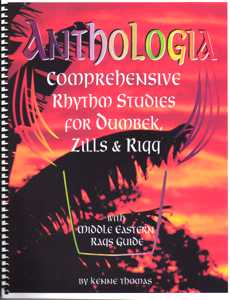
LINKS
ANTHOLOGIA.
by Kenne Thomas.
This newest book by author Kenne Thomas, is a categorized rhythmic study of the intricate and mesmerizing "Iqa'at," the modes and patterns of Middle Eastern dumbek drumming with sagat and riqq studies for ensemble and dance performance.
Chapter on dumbek instruments, "Iqa'at" (Rhythmic modes) and handing techniques with photographs.
Authentic Middle Eastern rhythm patterns from Adani to Zeimbekiko
Chapter covering rhythm terminology for reading and interpreting the Middle Eastern patterns.
Rhythms of al Andalus, the Balkans, Persia, the Maghreb, the Levant, and other regions.
Dumbek patterns and techniques for rhythm variations, improvisation and soloing.
Zills (Sagat, Finger Cymbals) chapter with rhythms for Takht (Inst. Ensembles) and Raqs (Dance) use.
Riqq patterns and techniques for takht (ensemble) participation, and improvised soloing.
Raqs al-Sharqi; Middle Eastern dance styles, descriptions and cultural reference guide.
Recommended recordings list of dumbek, zills, riqq and belly dance performance music.
Product review from author's site.

LINKS
PLAYING ALONG WITH MIDDLE EASTERN RHYTHMS COMPANION BOOK.
by Talisen.
24 pages by Bardic Productions
Companion booklet to the 2 CD's produced by Talisen.
Product review from author's site.
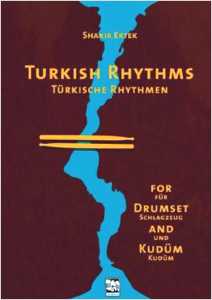
LINKS
TURKISH RHYTHMS FOR DRUMSET AND KUDUM.
by Shakir-Ertek.

LINKS
ORIENTAL RHYTHM COLLECTION.
By Rüdiger Maul.
N.B. This is in German and English.
"This rhythm collection with 112 rhythms from 21 countries offers a
comprehensive insight into the world of the oriental percussion.
The differentiating notation makes possible for the knowledgeable
as well as the self-taught, a clear understanding of the rhythms,
which are illustrated in the accompanying CD. In this way, this book
is equally appropriate for beginners and experienced musicians.
The structure progresses through 9 chapters, from easy until very
complex irregular beats, in which common dance rhythms , as well
as the rhythms of the Sufis too are included.
An additional ´´ special ´´ is offered on the DVD, on which the application
and playing techniques of the most important oriental -, but also
other popular percussion instruments are illustratively explained:
Darabukka, various frame drums like the Mizhar, Tar, Bendir, Duff and
Riq, Davul, Bongos,congos, Djembe and Cajon
The ensemble compositions, as stimulation for playing together, are
seen on the DVD as well." - Product Description from author's website
Eastern rhythm collection - Rudiger Maul - Book + CD + DVD
Language: English, German
Work conceived around the Eastern percussions and rates/rhythms of the East and Middle-East, the method of the German musician Rudiger Maul is a complete teaching support.
Composed of a book of a hundred pages, CD and a DVD, the method combines several elements to apprehend rates/rhythms and to transpose them on various instruments.
The author drew his sources in many meetings and a thick bibliography and discography, which enables him to propose 112 rates of 21 areas. Initially played on the drums of the East (darbouka, to bendir, riqq, daff, davul,…), the rates/rhythms presented are also intended to enrich the set of drums of other musical surfaces. To adapt a Bulgarian or Turkish rate/rhythm on a conga, or a Moroccan rate/rhythm on a cajon, such is the stake of Rudiger Maul.
Cut out in 9 chapters, the work is built to work carefully. Each page consists of a title page white (not to divert the eye) and it book is connected with a spiral in order to be to handle easily or place on a desk.
The author uses a clear nomenclature with the use of the conventional musical theory and onomatopoeias. The quality of the book and the recording of CD and the DVD, give a beneficiation on the work of this young German artist. Strike instruments are not studied as a whole and their alternative, and this method will be thus an ones complement a bibliography on the percussions of the world.
Member of the group “Faun” and sideman artists jazzmen like the beater Joachim Kühn, the work of Rudiger Maul is a mixture between the East and occident with a rather simplistic vision. A method intended for the musicians of mean level for advanced.
Details
• Deliver connected (spiral)
• Hard-bound cover
• audio 1CD + 1DVD
• Format: 23 X 30.5 cm.
• Pagination: 100 pages
Product review from author's site.

LINKS
LA DERBOUKA.
by Philippe Vigreux.
N.B. This is in French !!!
Language: French
This work, halfway between an instruction book and a rhythm directory, is a best-seller among french-language books on the matter. Although it does not include any video or audio material, this book is the work of a goblet-drum enthusiast as well as an Arabic civilization specialist.
The rich, well-written texts lead us onto the paths of a very widespread instrument in North Africa and the Middle-East.
Philippe Vigreux is a musicologist specialized in arabic cultures, a percussionist and a translator of arabic authors. He presents with this book, a successful attempt at restoring a knowledge that is usually transmitted orally.
The book divides into 8 chapters that release plenty of information gathered by the author during his many travels in this region of the world.
Suitable for beginners and initiates alike, this work is the perfect companion for the "Drâbkî" (Darbuka player) and has become a reference for specialists.
Product review from author's site.

LINKS
METHODE DE DERBOUKA - RHYTHMS DU MAGHREB ET D'ORIENT.
by Khalfa Dahmane.
N.B. This is in French !!!
This method of Derbouka presents in a simple way of the rates/rhythms of the Maghreb (Algeria, Morocco, Tunisia) and of the East (Egypt, Syria, Lebanon, country of the Golf). Dahmane Khalfa called upon several musicians to ornament the musical beaches with melody instruments such as the nay, the kanoun, the lute, the mezmar, the goumbri, and of the percussions like the karkabous, the saguettes, the def, the req or to bendir it, thus putting value the richness of the derbouka. This method is accompanied by a booklet and audio CD.
Product review from author's site.
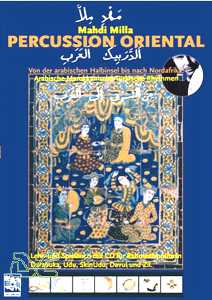
LINKS
PERCUSSION ORIENTAL.
by Mahdi Milla.
N.B. This is in German !!!
From the Arab peninsula to North Africa:
Arab, Moroccan and Turkish rhythms
Paperback Book with CD
Product review from author's site.
LINKS
THE TECKRONOMICON.
by Kevin Hartnell.
OUT OF PRINT / UNAVAILABLE
"The "Tekronomicon" is a book of over 100 exercises and drills for the aspiring darbuka (doumbek) player and features a primer on learning split finger/hand technique throughout.The "Tekronomicon" is designed to help the drummer to build skills by establishing a regimen of various exercises and rhythms to work on. The book features basic through advanced material (plenty of photos too!), including traditional rhythms and plenty of variations featuring split finger/hand technique as popularized in Turkey. This technique divides each hand into two striking areas which can increase speed and dexterity as well as providing a fun challenge to players of all levels."
Product review from author's site.
